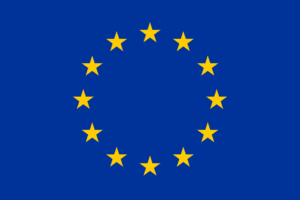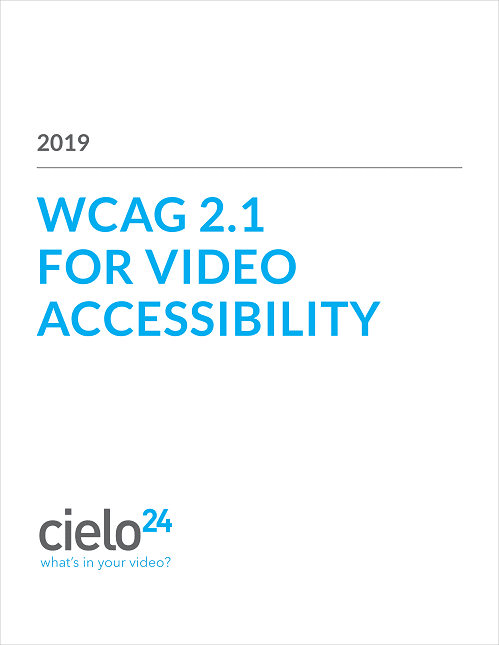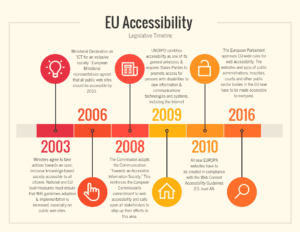
EU Internet Accessibility Laws and Policies
There are several impactful EU internet accessibility laws and policies that ensure equal access for individuals with disabilities across the globe. These laws work to bring accessibility to the public and often the private sectors. Let’s dive in.
Adoption of the United Nations Convention on the Rights of Persons with Disabilities
The first of the three EU internet accessibility laws and policies we will discuss is the UNCRPD. In 2010 the EU ratified the United Nations Convention on the Rights of Persons with Disabilities (UNCRPD). This treaty’s purpose is to:
promote, protect and ensure the full and equal enjoyment of all human rights and fundamental freedoms by all persons with disabilities, and to promote respect for their inherent dignity.

Founded on eight general principals, the UNCROPD makes great strides in improving access and quality of life for individuals with disabilities. These principles include:
- Respect for inherent dignity, individual autonomy including the freedom to make one’s own choices, and independence of persons
- Non-discrimination
- Full and active participation and inclusion in society
- Respect for difference and acceptance of persons with disabilities as part of human diversity and humanity
- Equality of opportunity
- Accessibility
- Equality between men and women
- Respect for the evolving capacities of children with disabilities and respect for the right of children with disabilities to preserve their identities
In terms of EU internet accessibility, two Articles directly address it: Article 9 – Accessibility and Article 21 – Freedom of expression and opinion, and access to information.
Article 9 states that persons with disabilities should be able to live independently and participate fully in all aspects of life.
It requires States Parties to take appropriate measures to ensure to persons with disabilities equal access to the physical environment, transportation, information and communications (including information and communications technologies and systems), and other facilities and services open or provided to the public.
Article 21 states that States Parties must ensure that people with disabilities can exercise their right to freedom of expression and opinion.
This includes the freedom to seek, receive, and impart information and ideas on an equal basis with others through all forms of communication of their choice. Requirements include:

- Providing information intended for the general public to persons with disabilities in accessible formats and technologies appropriate to different kinds of disabilities promptly and without additional cost
- Accepting and facilitating the use of sign languages, Braille, augmentative and alternative communication, and all other accessible means, modes, and formats of communication of their choice by persons with disabilities in official interactions
- Urging private entities that provide services to the general public, including through the Internet, to provide information and services in accessible and usable formats for persons with disabilities
- Encouraging the mass media, including providers of information through the Internet, to make their services accessible to persons with disabilities
- Recognizing and promoting the use of sign languages
In total, 50 articles cover different areas of disability life such as Health, Education, Liberty of movement and nationality, Women with disabilities, etc.
WCAG, Example of EU Internet Accessibility Leadership
It is essential to know WCAG inside and out because many jurisdictions around the world have adopted the guidelines into their laws and policies. WCAG was developed as an international baseline for accessibility, so rules will start with these requirements as a foundation and build on them if necessary.
The WCAG guidelines focus on development and presentation of web content, meaning “natural information such as text, images, and sounds, and/or code or markup that defines the structure, presentation, etc.” These international technical standards are created and managed by the World Wide Web Consortium (W3C). Its mission is to lead the World Wide Web to its full potential by developing protocols and guidelines that ensure the long-term growth of the Web.

In 1999, the W3C’s Web Accessibility Initiative (WAI) created the first round of guidelines called WCAG 1.0. Since then, the guidelines have been updated to WCAG 2.0, which apply more broadly, addresses new technologies, are testable, and are easier to understand. They are used as primary guidance for the development of accessibility requirements in almost nearly every country with technical infrastructure. And they represent the standard internet experience that people everywhere have come to expect when surfing the web and interacting with virtual content.
As technology continues to expand, exponentially influencing our lives more every day, the guidelines used worldwide to ensure accessibility to all individuals must extend, as well. This past June of 2018, the World Wide Web Consortium (W3C) published the latest update to the Web Content Accessibility Guidelines, version 2.1.
Conforming to Success Criteria WCAG defines time-based media like audio, video, or synchronized media that will run for a specified length. Examples include audio of a speech or a webinar. Synchronized media is audio or video content that is joined by another presentation format.
EU Directive
One of the most recent EU internet accessibility laws and policies is the EU Internet Accessibility Directive, which applies to websites and mobile apps of public bodies in Europe. On October 26, 2016, the European Parliament approved the directive which establishes EU-wide rules for accessibility on public sector websites and mobile apps. Further, as of 2018, the EU Directive is fully aligned with WCAG
According to EU Directive ruling, the sites and apps of public administrations, hospitals, courts, and other public sector bodies in the EU will have to be made accessible to everyone. The web accessibility directive should make it easier for disabled and older adults to access data and services on the internet, i.e., to file a tax declaration, apply for an allowance, pay fees or enroll at a university.
The Commission first proposed the directive in 2012. Following negotiations between the European Parliament, the Council and the Commission, an updated version of the directive was agreed in May 2016, and adopted by the Council in July 2016.
Once the directive is published in the EU Official Journal, member states will have 21 months to add it into their national laws. They then have 12 months to apply the provisions to new websites, 24 months to apply them to existing sites, and 33 months to apply them to public sector bodies’ mobile applications.
The Directive:
- Covers websites and mobile applications of public sector bodies with a limited number of exceptions (e.g., broadcasters, live streaming)
- Establishes the standards used to make websites and apps more accessible
- Requires regular monitoring and reporting of public sector websites and mobile apps by the Member States
EU Leadership, Combination of the EU Directive and WCAG

The European Union (EU) Directive on the Accessibility of Websites and Mobile Applications requires EU member states to make sure their websites and mobile apps meet common accessibility standards. The Directive are transposed into the laws of each EU member state by September 23, 2018.
The Directive uses the four principles of the Web Content Accessibility Guidelines (WCAG), requiring that public sector organizations across the EU take steps to make sure their websites are “Perceivable, Operable, Understandable, and Robust.”
The Directive references EN 301 549 as the standard which will enable websites and apps to comply with the law. EN 301 549 is a set of Functional Accessibility requirements broken down into chapters, and chapter 9 on Web Content cites WCAG 2.0 Level AA and WCAG 2.1 as the expected standard.
Once adopted into the laws of each EU member state, the Directive sets a timetable for compliance with the new regulations:
- New public sector websites must conform by September 23, 2019
- All public sector websites by September 23, 2020
- All public sector mobile apps by June 23, 2021
To comply with the Directive, public sector organizations will need to monitor the accessibility of their websites and apps, make information from the monitoring available in an accessibility statement and provide reports to a central authority. These requirements mean that many EU public sector organizations will need to rethink their accessibility strategy in the coming months if they are to be ready when the Directive came into effect on September 23, 2018.
European Standard for Accessible ICT Products and Services

In 2005, The European Commission issued Mandate 376 to the three European Standard Organizations (CEN, CENELEC, and ETSI) to work on the development of functional accessibility requirements to be used in public procurement of ICT products and services
In January 2014, CEN, CENELEC, and ETSI announced the publication of the EN 301 549 ‘Accessibility requirements suitable for public procurement of ICT products and services in Europe’, as the first European Standard for accessible ICT products and services.
The Standard was developed by an international team of experts, with the participation of the ICT industry and organizations representing consumers, people with disabilities, and older persons.
The new European Standard and three Technical Reports (TR 101 550, TR 101 551 and TR 101 552) establish accessibility requirements for products and services related to ICT, including computers, smartphones, and other digital devices, ticketing machines, websites, and emails.
The Standard ensures that ICT products and services are accessible to everyone either directly or with assistive technologies such as text-to-speech.
Summary
While all EU sites are required to meet WCAG conformance, public sector websites today are far behind. According to the EU Parliament, only one-third of the 761,000 EU public sector websites meet basic web accessibility standards. In its estimation, more than 167 million EU citizens have difficulty in accessing public websites to use public internet services.
The responsibility of the ‘internet’ to meet an equal opportunity standing for all people is essential, with the exponential rate of online-only information. It is the clear example, and concerted efforts by the EU member states work on the digital front that we should all be proud. The adoption of the EU Directive should significantly improve access to individuals with disabilities in the European Union. Stay tuned for any updates to EU internet accessibility laws and policies.
Getting Ahead of Audio and Video Captioning and Transcription
 A fast, affordable option to roll-out a media caption and transcription plan is to to sign up for the Self Serve caption and transcript web app, which allows you to get started immediately without the wait for contracts or quotes. Self Serve gives you a receive a free caption and transcript, and then human-verified transcriptions and captions begin at less than $1/minute.
A fast, affordable option to roll-out a media caption and transcription plan is to to sign up for the Self Serve caption and transcript web app, which allows you to get started immediately without the wait for contracts or quotes. Self Serve gives you a receive a free caption and transcript, and then human-verified transcriptions and captions begin at less than $1/minute.
Another option – especially if you know you have an extensive video library to manage and must meet WCAG guidelines and other EU internet accessibility regulations, is to inquire about our Enterprise plans that are built around your specific needs. Through all Enterprise plans, you also have access to our full suite of video and audio data solutions – like 17 foreign language translations, advanced media data, and our video wrapper. For more information on our video transcription accuracy, captioning and video intelligence solutions, contact us online or call us at 1-855-243-5624.
cielo24 is removing barriers to increase video marketing ROI, searchability, and compliance for all your videos!

